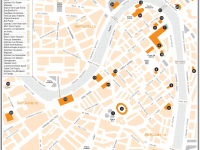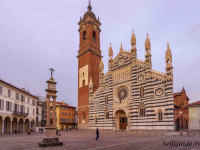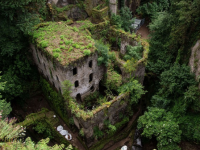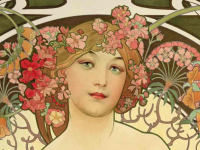Главная > Италия > Регион Кампания > Неаполь > В окрестностях Неаполя
Торре Аннунциата (Torre Annunziata) в ближайших окрестностях Неаполя была построена на руинах древнего города Оплонтис (Oplontis). Название городка произошло от смотровой башни — torre — построенной для предупреждения населения о приближающихся набегов сарацинов, и от часовни, посвященной Деве Марии (Annunziata), вокруг которой вырос город.
В 18-м веке Карл III основал здесь оружейный завод, спроектированный учеником Ванвителли и законченный Фердинандо Фуга. В конце 1700-х и начале 1800-х Торре
Аннунциата стал центром для производства макаронных изделий. Со стороны моря расположен спа-курорт, Термы Vesuviane Nunziante, названнын в честь генерала, который обнаружил здесь в 1831 руины комплекса римских бань. Он отвечал за современную версию терм, которая до сих пор используется.
Туристический офис: Pro Loco Ufficio Informazioni Turistiche: Via Sepolcri 16. Tel 081 862 31 63.V
Добраться: поезд Circumvesuviana: Torre Annunziata.
Археологическая зона Оплонтис
Via Sepolcri 1.
Тел 081 857 53 47.
Время работы:
Площадь раскопок включает в себя виллы Craxus и Poppaea (последний был Нерона
Вторая жена). Привлечены к свету в 1964 году, комплекс отражает элегантный вкус своих владельцев. Помимо больших садов и портиков, частные бани дома также можно увидеть, в комплекте с calidarium (горячая комната) и тепидарием (теплая комната). Также интересными являются 1-ое столетие в.н.э. настенные росписи BC-1-я.
Эти фрески изображают натюрморты или сцены, сочетающие архитектуры и цифры, в некоторых случаях с illusionistic эффектами вокруг дверных проемов и окон. Многие амфоры были найдены в комнатах виллы Craxus, которые использовались в качестве складских помещениях или магазинах.
Раскопа участки Oplontis расположены в центре современного города Торре Аннунциата.
Единственное документальное подтверждение имени Oplontis в Таблицах Певтингера, средневековой копии древней карты дорог, существующих в Италии во время Римской империи. Название места Oplontis относится к несколько зданий, расположенных между Помпей и Геркуланума.
Следовательно, ряд археологических находок были приписаны Oplontis, которые на самом деле относятся к пригородной зоне Помпеи. Они состоят из жилой виллы, известный как вилла «Poppea»; деревенский дом думал принадлежать к L. Crassius Tertius, в котором большое количество золотых и серебряных монет, наряду с богатством изысканных ювелирных изделий, были найдены лежал рядом с многочисленными телами жертв извержения; и термальные ванны расположены в районе Ончино, под настоящим Терме Nunziante Spa, который А. Maiuri приписывает консулом М. Красс Frugi.
Главный памятник, который является единственным местом открыт для посетителей, и в список ЮНЕСКО в качестве «Всемирного наследия», является вилла Poppea. Этот гранд-жилое здание, первоначально построен в середине 1-го века до н.э., был продлен в имперский период и ведутся ремонтные работы во время извержения. Это объясняется вторая жена императора Нерона, Поппея Сабина, но принадлежит более общем сословий царской семьи.
Посещение
Oplontis обоснованно считается жилой центр с большим вилл, оснащенных станциями для освежения лошадей, бань и гостиниц для путешественников и мест для хранения и продажи сельскохозяйственной продукции плодородной Везувия области.
Легенда гласит, что Oplontis был жилой дом Поппеи, женщины, известной она Краса молочные ванны.
Вилла Poppea
Вилла Poppea был построен в 1 веке до Р. Х. а затем расширен в Клавдиев возрасте. Вилла великолепна своими размерами, качеством его фресками и многочисленных мраморных скульптур.
Вилла должна была принадлежать Поппея Сабина, вторая жена императора Нерона, из надписи на амфору к Секунд, вольноотпущенник Poppea. В самом деле, императорская семья используется, чтобы провести некоторое время на кампанской побережье, так как многие семьи патрициев, чтобы наслаждаться здоровым климатом, как это показано на роскошных жилых вилл здесь найдено (Otium виллы).
Вилла была необитаема в момент извержения. Существовали ни мебель в комнатах, ни на кухне. Многие объекты, найденные, такие как колонны и масляных ламп, было сложено в несколько комнат.
Строительные материалы и работа в процессе доказать, что они устранения повреждений, вызванных к вилле одним из частых землетрясений в районе Везувия.
Здание находится с востока на запад и включает в себя оригинальный центральный участок с видом на сад, на который были добавлены два крыла и портик.
Оригинальный вход и фронт не раскопаны и расположены за пределами искусственного канала 16-го века Конте ди Сарно, под современной застроенной территории.
Вилла, окруженная большим садом, имеет тепловую четверть и продуктивных мест, таких, как один для ступая винограда и производства вина.
Живописные украшения созданы перспективные эффекты и отношения между реальностью и нереальностью, путем смешивания бутафорские двери и колонны с реальной архитектурой. Детали украшения были многочисленны и высокой quality.They представленных масок, фруктовых корзин, факелами и птиц.
Вилла была первоначально украшено много скульптур, преимущественно римских копий эллинистических оригиналов со 2-го — 3-го B.C века ..
Восточная сторона была почти полностью раскопаны, в то время как часть западной стороны находится под современной дорогой и военного строительства, старая Real Fabbrica d’Arm
The excavation area includes the villas of Craxus and Poppaea (the latter was Nero’s
second wife). Brought to light in 1964, the complex reflects the elegant taste of its owners. As well as large gardens and porticoes, the private baths of the house can also be seen, complete with calidarium (the hot room) and tepidarium (the warm room). Also interesting are the 1st century BC–1st century AD wall paintings.
These frescoes depict still lifes or scenes combining architecture and figures, in some cases with illusionistic effects around the doorways or windows. Many amphoras were found in the rooms of the Villa of Craxus, which were used as storerooms or shops.
The excavation sites of Oplontis are located in the middle of the modern town of Torre Annunziata.
The only documentary evidence of the name Oplontis is in the Tabula Peutingeriana, a medieval copy of an ancient map of the roads existing in Italy at the time of the Roman Empire. The place name of Oplontis applies to a few buildings situated between Pompeii and Herculaneum.
Hence, a series of archaeological finds have been ascribed to Oplontis which in fact relate to a suburban area of Pompeii. They consist of a residential villa, known as the villa of » Poppea «; a rustic villa thought to belong to L. Crassius Tertius in which a large quantity of gold and silver coins, along with a wealth of exquisite jewellery, were found lying next to numerous bodies of eruption victims; and thermal baths situated in the Oncino area, underneath the present Terme Nunziante Spa, which A. Maiuri has attributed to the consul M. Crassus Frugi.
The main monument, which is the only site open to visitors and listed by UNESCO as a “World Heritage Site”, is the villa of Poppea. This grand residential building, originally constructed in the mid-1st century BC, was extended during the Imperial Period and was undergoing renovation work at the time of the eruption. It is attributed to Emperor Nero’s second wife, Poppaea Sabina, but belongs more generally to the imperial family’s estates.
Visit
Oplontis is reasonably thought to be a residential centre with a great deal of villas equipped with stations for the refreshment of horses, baths and hotels for travellers and places for the storing and sale of agricultural products of the fertile Vesuvian area.
The legend says that Oplontis was the residential villa of Poppea, the woman famous for she’s beauty milk baths.
Villa of Poppea
Villa of Poppea was built during the 1st century B.C. and then enlarged in the Claudian age. The Villa is magnificent for its dimensions, the quality of its frescoes and the numerous marble sculptures.
The Villa was supposed to belong to Poppaea Sabina, emperor Nero’s second wife, from an inscription on an amphora to Secundus, a freedman of Poppea. Indeed, the imperial family used to spend some time on the Campanian coast, as many patrician families, to enjoy the healthy climate, as shown by the sumptuous residential villas here found (otium villas).
The Villa was uninhabited at the moment of the eruption. There were neither furnishings in the rooms nor in the kitchen. Many objects found, such as columns and oil-lamps, were piled up in few rooms.
Building material and work in progress prove that they were repairing the damages caused to the Villa by one of the frequent earthquakes in the Vesuvian area.
The building lies east to west and comprises the original central section overlooking the garden, onto which were added two wings and a portico.
The original entrance and the front are not excavated and are situated beyond the 16th century artificial canal of Conte di Sarno, under the modern built-up area.
The Villa, surrounded by large gardens, has a thermal quarter and productive places, such as the one for treading grapes and producing wine.
The pictorial decoration created perspective effects and relations between the reality and the unreality, by mixing sham doors and columns with the real architecture. Details of decorations were numerous and of high quality.They represented masks, fruit baskets, torches and birds.
The Villa was originally adorned with many sculptures, prevalently Roman copies of the Hellenistic originals from the 2nd — 3rd century B.C..
The eastern side has been almost completely excavated, while part of the western side lies under a modern road and a military building, the old Real Fabbrica d’Arm

Oplontis site is reachable in half an hour from the train station of Naples by train, bus, highway.
Train
Circumvesuviana — Naples — Sorrento Torre Annunziata
Ferrovie dello Stato Napoli Centrale — Pompei Actually out of order
Bus
SITA SUD Torre Annunziata
Car
Highway A3 Torre Annunziata
Opening times
1st April – 31st October: daily from 8.30 am to 7.30 pm (admission closes at 6 pm)
Closing day: 1st May
1st November – 31st March: daily from 8.30 am to 5 pm (admission closes at 3.30 pm)
Closing days: 25 December and 1st January
How to get there
By train:
Circumvesuviana Naples-Sorrento (Torre Annunziata Stop)
Circumvesuviana Naples-Poggiomarino (Torre Annunziata Stop)
By car:
A3 Naples-Salerno Motorway (Torre Annunziata Sud Exit)
Tickets
With access to 3 sites (Oplontis, Stabiae, Boscoreale) — valid for 1 day
Full price: € 5,50
Reduced price: € 2,75 (*) (*) Reduced ticket for European Union citizens aged over 18 and under 25 and for European Union state school teachers.
With access to 5 sites (Pompeii, Herculaneum, Oplontis, Stabiae, Boscoreale) — valid for 3 days
Full price: € 20,00
Reduced price: € 10,00 (*)
Free ticket: European Union citizens under 18.
Tickets and group reservation ph. 199 757517
Главная > Италия > Регион Кампания > Неаполь > В окрестностях Неаполя




